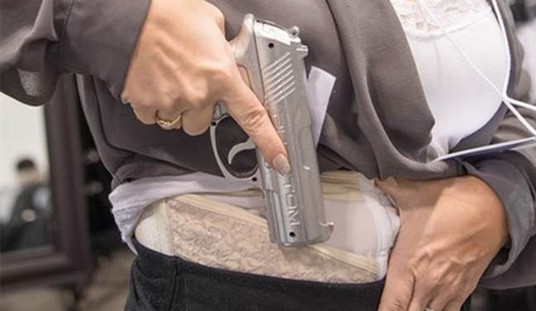
For many years – based on my training in shooting previously identified, stationary, paper targets on ranges – I invested in tritium night sights on those firearms that I thought I’d be most likely use in self-defense. I try to remain open-minded but, at this point, I seriously doubt that I’ll be spending any more money self-illuminating sights in this lifetime.
A while back, I discussed this issue with my former shooting partner Harold Flynt, who spent a large part of his career on LASD in training-related assignments. He commented that he had repeatedly been asked by other deputies whether he recommended that they put night sights on the guns they carried on duty. His standard response was to inquire,”If you can’t see your sights, are you sure that you’ve positively identified your target?”
I make it a point to carry at least one handgun accessible to either hand. The two on my belt are identical models, as are the flashlights clipped into the outer edges of my back pants pockets. My experience with modern flashlights has been that they either provide enough spillover or reflected light, if not to see the sights clearly, to see enough of the shape of the gun to use Jim Cirillo’s weapon silhouette point technique.
I use the original SureFire Aviator A2 lights, in which an array of three LED bulbs surrounds a high-intensity Xenon bulb. These lights use a two-position end-cap switch that first turns on the colored LED’s, then, on further pressure, turns on the brighter white light. I specifically chose red for the LED’s as red – particularly at low intensity – tends not to affect night vision. Thus, light pressure on the switch allows me to perform “administrative” tasks without affecting my residual vision when I’m done with them.
The current version of this light also uses battery-sparing LED’s for the high-intensity phase but I’ve yet to rationalize using a significant chunk of a Social Security check to purchase a couple of the newer model.
As LED technology has evolved, the output of some hand-held lights as reached levels undreamed of years ago. One of the most valuable concepts that I learned in an academic setting is that fact is the greatest enemy of theory. Theoretically, turning night into day sounds great, particularly if it blinds your assailant when you do so. In fact, it makes no tactical sense to leave your light on continuously in a gunfight environment and when you shut off one of the mega-lights, you’ll be blinded—if only temporarily – as well.
A good starting point for the tactics of low light operation is the maxim, “If you’re in the dark, stay in the dark. If you’re in the light, light up the dark.” As intimated above, however, walking around with your light on continuously may make you a good target. Thus, most people who understand this stuff advise the use of intermittent flashes of light, interspersed with movement. Seldom addressed is the fact that modern, high-intensity lights glow briefly when they go off. Thus, as you initiate your movement, you may want either to move your just extinguished light in the opposite direction or to point it downward.
Briefly back to night sights… Several people have commented – some seriously, some in jest – that a nice feature of having the tritium “bulbs” in your sights is that they help you locate your gun if you are awakened suddenly. Perhaps. Not everyone who has just been awakened ought to have a gun in hand right away, particularly if it’s got a short-stroke trigger with no separate safety lever. Also, a couple of friends with more recent military experience than mine have commented that they’ve been on night exercises in which they’ve spotted members of “the other team” by the reflections of their night sights in eyeglasses. Similarly, if you’re forced to navigate unknown territory, your night sights may be visible to an assailant behind you.

(Drawing by Paige Robbins, copyright 2010, Defensive Use of Firearms, LLC)
Okay, perhaps some good flashlights are starting to sound like a wiser investment than tritium sights. What if you don’t have time to draw a flashlight? Probably the greatest evolution in my own understanding of the defensive use of firearms is that many people set up a false dichotomy between point shooting and sighted fire. The different techniques are more wisely viewed as different points along a spectrum that includes both distance and the need for speed versus the need for precision.
In my view, it is foolish not to spend some time training with body-index techniques for those (more likely) incidents in which your brain will be screaming to focus on the threat (including determining if it’s truly a deadly threat) and those in which bringing the gun up to the line of sight may risk a wrestling match over it. When the gun is fired from below the line of sight, it won’t matter how visible the sights are. I taught the aforementioned weapon-silhouette technique as a transition into sighted fire, suitable for when the shape of the gun is visible but the sights are not. It also allows a faster visual confirmation of muzzle alignment at intermediate distances, where speed may be crucial.
What about lasers? I am reluctant to stake my life on things that require batteries. (Note that I carry two primary flashlights.) In January 1998, I purchase a Crimson Trace LaserGrip for use as a teaching tool. It proved extremely useful as such over the next 14 years, However, one of the lessons learned from its use was that it twice failed on the range and, in neither case, was it due to exhausted batteries. After the second incident I realized that, under conditions of very low humidity, the fine dust that is common on the eastern side of Arizona can adhere to the contact points of the switch. There are lots of potential instructional uses for a laser sight but I once had to ask a student to turn his off. Rather than fire a shot on the basis of the body-index technique I was trying to teach him, he would first destroy that alignment by leaning over to see if the red dot was where he wanted it on the target. What if you become accustomed to seeing the red (or green) dot on the target on the range but don’t see it on the bad guy in the alley? Will you fire, in confidence that your body index will deliver the shot where it ought to go or will you wave the gun around to see where the red (or green) dot went?
And, while a laser may allow you to confirm the alignment of your muzzle, it will do nothing to help you positively identify your target.








Join the conversation as a VIP Member